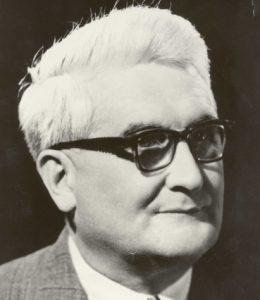László Kalmár
László Kalmár, a mathematician, had an extremely broad knowledge base and was able to quickly find his bearings in a wide variety of fields. This led him to mathematical logic in the 1920s and cybernetics in the 1950s, taking on the struggle for the domestication of these scientific fields. As a passionate educator, he also did everything he could for the higher education of these fields.
In 1956, he launched his famous cybernetics seminar at the University of Szeged (SZTE) – aiming to familiarize himself with the technical and other applications of mathematical logic and cybernetics. In the course of this, precisely by 1957, the “Kalmár-like logic machine” was completed – as one of the very first heralds of Hungarian informatics – and was officially presented at the University on May 1, 1958. In this atmosphere, the design of László Kalmár’s “formula-controlled computer” and Dániel Muszka’s “Ladybug of Szeged” were also born. – The logic machine and the Ladybug were presented with great success at the Budapest Industrial Fair in 1960. (We should mention that the MIR computer was built in Kiev under the leadership of Academician Gluskov, whose language was close to the ALGOL-60 language, based on Kalmár’s design.)
With his scientific and human authority (writing many letters), he fought to launch in the autumn of 1957 – for the first time in our country – the (calculator) applied mathematics training linked to single-year teacher training (the “Szeged School”), which became an independent major from 1963. In the successor (and predecessor) institution of SZTE, the József Attila University (JATE), he established the Cybernetics Laboratory in 1963, in which a computer (the M-3) was already operational in 1965. He was the head of the Department of Computer Science, established within the Bolyai Institute in Szeged in 1967, and of the Research Group of the Department of Mathematical Logic and Automata Theory of the Hungarian Academy of Sciences. The independent Department of Informatics, established in 1990 at the University of Szeged, adopted the name “László Kalmár Institute” in 1992.
Professor Kalmár is considered a domestic pioneer of computer science culture. With his public activity, he did the most in his time for the domestic acceptance of the new science, as well as for the cultivation of relations between domestic higher education and scientific institutions. He was a living catalyst among scientists, educators, researchers and users. – Between 1975-1976 he was the honorary president of the National Association of Computer Science and Engineering.
He became a corresponding member of the Hungarian Academy of Sciences in 1949, and a full member since 1960. His awards include: Gyula Kőnig Prize (1936); Silver Kossuth Prize (1950); First Class State Prize (1975); János Neumann Memorial Medal (NJSZT, 1976); Hungarian Heritage Award (2002, posthumously). His life's work was recognized by the Institute of Electrical and Electronics Engineers (IEEE) with the "Computer Pioneer Award" (1996, posthumously), which recognizes outstanding pioneers in computer history.
- Wikipedia
- László Kalmár memorial page - his life and work
- László Kalmár, the Hungarian pioneer of computer technology (Péter Gábor Szabó)
Kalmárium I., II.– Correspondence between László Kalmár and Hungarian mathematicians (compiled by: Péter Gábor Szabó ), Polygon, Szeged, 2005 and 2008.
Kalmár legacy in the Klebelsberg Library of the University of Szeged
- The beginnings of higher education in computer science in Hungary - at SzTE, then at JATE (pp. 45-69)
- "Uncle Laci is eternal" (writing, The Past of the Future - Informatics History Exhibition, Szeged)
- Correspondence of László Kalmár 1957-1961
- László Kalmár: Letters on the Logical Machine
- László Kalmár: Application of digital calculators and special purpose machines in medical diagnostics
- László Kalmár: Electronic mathematical machines in metallurgy
- András Ádám: On the mathematical work of László Kalmár (in: Matematikai Lapok 26. vol. 1977. no. 1-2. pp. 1-10.)
- commendation (English, Computer Pioneer Award, 1996.)
- He did a lot for the creation of applications of cybernetics and then computer technology – primarily in the fields of mathematics, linguistics, medicine and biology, and industry (primarily ferrous metallurgy).
- He maintained extensive correspondence with numerous Hungarian and foreign mathematicians (see Kalmár legacy).
Created: 2016.05.30. 11:29
Last modified: 2024.06.24. 21:54

